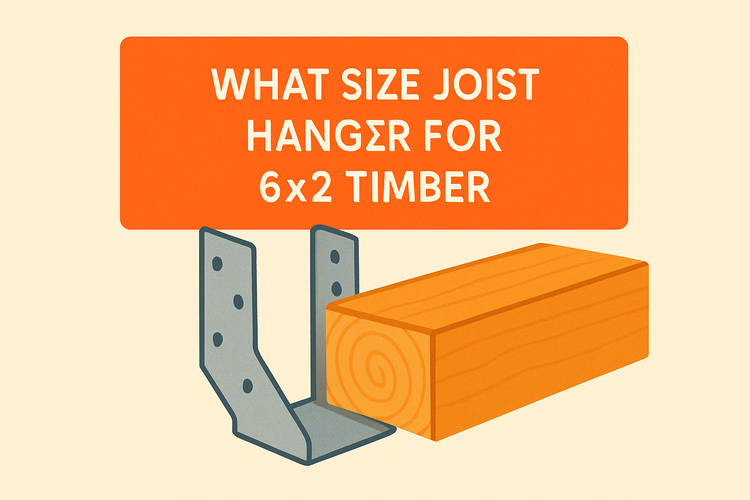What Size Joist Hanger For 6 X 2 Timber

Choosing the Right Joist Hanger Size for 6 x 2 Timber
When working with 6 x 2 timber, selecting the right joist hanger is critical to ensuring a solid and safe structural connection. Joist hangers must match the timber size to provide optimal support and reduce any risk of failure.
For standard 6 x 2 timber (which typically refers to timber that is approximately 150mm x 50mm in metric), a 150mm wide joist hanger is generally required. However, it’s also important to consider other factors such as load capacity, corrosion resistance, and the environment it’s being used in. These dimensions should match closely with the actual size of the timber after it’s been planed, which can differ slightly from nominal sizes.
You can explore multiple options that fit this dimension from the Joist Hangers category, which includes various designs such as face-fix, concealed flange, and heavy-duty variants. Each type has its own application depending on the design requirements of your project. Careful alignment and fastener selection are crucial for maximizing load distribution and strength.
Types of Joist Hangers for 6 x 2 Timber
There are several types of joist hangers that are compatible with 6 x 2 timber, each tailored for specific applications.
Face-fix joist hangers are among the most commonly used for general framing and are ideal for securing joists to vertical surfaces like ledger boards or beams. They attach directly to the face of the header or beam and allow for a quick, simple installation. These are often used in decking and internal flooring structures.
Concealed flange joist hangers are a more discreet option, offering a cleaner visual finish by hiding the flanges inside the joint. These are suitable when aesthetics are as important as strength. They’re slightly more complex to install but are often chosen for architectural or exposed timber designs.
Heavy-duty and long leg joist hangers accommodate additional load requirements or variations in drop height. They are essential in high-load areas, such as floors supporting heavy furniture or appliances. All of these options can be browsed under the Joist Hangers collection.
Installation Tips for Maximum Stability
Proper installation of joist hangers is crucial to maximizing the strength and lifespan of your timber connections.
Start by ensuring that the timber and hanger are flush and aligned before fixing. Use the correct type and length of nails or screws approved for the specific hanger model being used. Using a fastener not intended for joist hangers can compromise structural integrity over time.
Ensure that each nail hole is filled with a suitable fastener as specified by the manufacturer. If any holes are left empty, the load-bearing capacity of the joist hanger may be significantly reduced. Always check to ensure hangers are installed straight and level to avoid misalignment of the joist or beam.
When dealing with additional support applications such as cross-laminated timber or glulam connections, consider reinforcing your structures with specialized brackets or Connectors for Glulam Timber. These accessories enhance the overall resilience of your timber joins and extend their durability in demanding environments.
Common Mistakes to Avoid
Even slight misjudgments in hanging joists can compromise timber stability. Avoid these frequent errors to ensure lasting structural integrity.
One common mistake is choosing a joist hanger that doesn’t match the depth or width of the timber. A hanger that’s too wide or shallow will not provide adequate bearing support, potentially leading to sagging or failure over time. Always confirm the actual dimensions of your timber before purchasing hangers.
Another issue involves improper fastening. Using drywall screws or undersized nails instead of the manufacturer-recommended fasteners can weaken the connection. Similarly, relying on adhesives without mechanical fixing is never sufficient for joist applications.
Neglecting to factor in the environmental conditions where the joist hanger will be used can also lead to premature corrosion. For outdoor or damp environments, it’s essential to use galvanized or stainless steel variants found within the Joist Hangers range to ensure long-term resistance against moisture and decay.
Additional Support Brackets and Connectors
While joist hangers are primary supports, additional connectors can offer enhanced durability when building complex structures with 6 x 2 timber.
Angle Brackets can be used in conjunction with joist hangers to add diagonal strength, especially in seismic zones or where lateral support is critical. These brackets help distribute shear loads and reinforce the joint from multiple angles.
Likewise, if your structure requires anchoring to masonry or concrete, other products like Post Bases or masonry-specific connectors may be required. These added supports are essential in bridging connections between different structural components and increasing the lifespan of timber installations.
For high-load-bearing or external applications, incorporating multiple components like restraint straps or high-wind connectors ensures the overall resilience of your framework. These can be explored in different related categories alongside your joist hangers to offer comprehensive support solutions.
